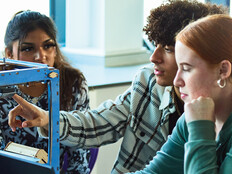Editor’s note: To help IT leaders prepare for the year ahead, EdTech is pulling together the biggest tech trends for K–12 districts in 2022. You can find our overall top trends here, and be sure to check out our trends in artificial intelligence and cloud technology.
A year and a half of online and hybrid learning showed the nation that there is more than one way to learn. Many students found that online education suited their learning style and opted to stick with it even after classrooms reopened their doors. Virtual-only schools saw a rise in admissions, and traditional schools created their own permanently virtual options. With this shift to distance learning came an additional insight: School doesn’t need to be in session for eight hours a day, from 7 a.m. until 3 p.m.
In a poll of K–12 educators in August, a majority of respondents said that self-paced or asynchronous learning was the No. 1 element they would like to see carried into the classroom this school year.
Students, too, have lauded the benefits of asynchronous learning. “It’s more like college — you have to go at your own pace, and you don’t have a bell telling you when to eat, when to learn, when to stop learning,” Elias Grabowski, a student at Kennebunk High School-Maine Regional School Unit 21, said in a March CoSN2021 interview with EdTech.
Educators and students alike have seen benefits with asynchronous models, including the freedom to complete schoolwork at their convenience. For many, the experience is new, and some schools, such as Oklahoma City Public Schools, are still testing out asynchronous options one day at a time. For others, however, asynchronous learning has always been part of how their school operates.
Virtual Schools Find Higher Student Engagement in Asynchronous Projects
“I think there’s an opportunity to learn from what we’ve all experienced during this pandemic, and for us to realize that schools don’t have to be a place,” says Chris Wilson, Head of Schools for Sora Schools, a virtual high school.
Sora’s students take part in asynchronous, project-based learning, and Wilson says students are more engaged when they’re able to work on projects they have a hand in designing. “They need to be intrinsically motivated to engage in the project,” he says. “We begin planning for learning around questions of inquiry.”
MORE ON EDTECH: Bring STEM to K–12 students with mobile technology.
These projects lead students to ask deeper questions, and they keep students motivated in a variety of courses; for example, a project on launching rockets or coastal conservation spans a number of math and science disciplines. Students also become more motivated by the freedom they’re given to complete the work on their own time. Learning asynchronously, students have more time for clubs and activities — or, for high schoolers, maybe a job they couldn’t fit into a traditional school schedule.
Mickey Revenaugh, vice president for business development and global online learning at Pearson Online Academy, notes how the academy takes a different approach to asynchronous instruction with a flipped classroom model.
“The idea of flipped learning puts more onus and responsibility on the students to master the basics of material outside of class and then spend their in-class time debating, discussing, doing projects and working on the higher-order thinking skills,” she says.
There are many lessons traditional brick-and-mortar schools can take from online education when designing asynchronous learning options. Schools should look for a model that works for their staff and students and that uses the technology they already have in hand.
Click the banner below to be the first to learn about new trends in K–12 educational technology.
Schools Equip Students with Needed Tech for Asynchronous Learning
For asynchronous education to succeed, students and educators need technology access. Outside of the classroom, it’s crucial that students have access to devices and a reliable internet connection to meaningfully engage with classwork.
Oklahoma City Public Schools is testing a model that incorporates asynchronous days throughout the school year. Each student in the district has been provided with a device: The district rolled out a one-to-one program last year, and returning students kept those devices, while new students were issued devices at the beginning of this school year.
“Make sure that students have good internet access at home or wherever it is that they might be doing their work,” Revenaugh says. “It could be that your whole community becomes your school building, and students should have access wherever they might be.”











